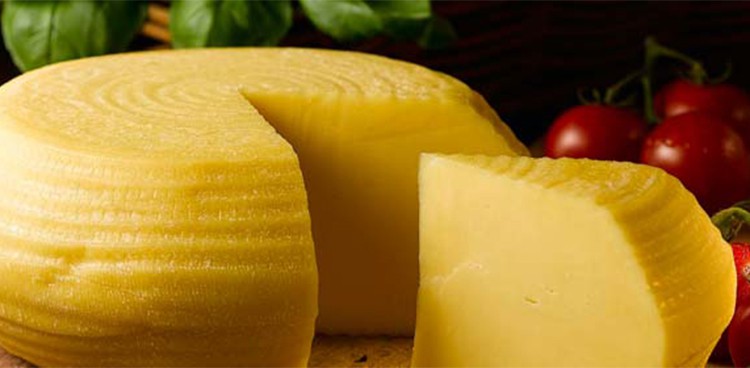
When the sophisticated turophile at your cocktail party starts gesturing wildly with her Champagne glass and talking about cheeses that certifiably have PDO—Protected Designation of Origin—status, the first things that pop into your head might be French cheeses like Camembert or Swiss ones like Gruyère. Parmigiano Reggiano, you try to remember to say, keeping in mind that the good ol’ Italian grating (or pretty much anything) cheese needs to come from the regions of Parma or Reggio to be counted as the real deal.
Well, let me introduce you to a marvelous little guy that’s just as particular about its production process, point of origin, and certification as any of these Continental fromages: Imokilly Regato, Ireland’s one and only PDO cheese. The name sounds like it belongs more to a Jedi than an Irish dairy product, but if you happen to be in Ireland, Imokilly Regato—named after the old barony of Imokilly, from an ancient Gaelic place name Uí MacCaille—is the perfect authentic specimen of the Emerald Isle for your St. Patrick’s Day spread.
All right, so it’s PDO. That means it’s ancient, right?
Well, yes and no. The Irish province of Munster, in the south of the island, has a long history of making cheese dating back to pre-medieval times (so neither utensils nor Pepsi). Until the sixteenth century, the big movers and shakers of the south Irish cheese world were monasteries and abbeys. As part of their commitment to sustaining an entire community devoted to, ya know, God, monks milked the cows, cut the curds, and generally aged their cheeses to dairy perfection.
Irish cheesemaking undertook a big shift when—to condense centuries of Irish-English relations into an article about cheese—thousands of Englishmen and -women were brought in by the English crown during the Plantation of Munster. Native Irish who had fought against English influence had their lands taken away from them and given to English, Anglican settlers who were to form a new ruling class for the next couple hundred years. Cheesemaking now revolved around the big English landlords’ houses, which remained the case until around the post-WWII establishment of the Republic of Ireland.
Fast-forward to 1973: Ireland joins the European Economic Community (a precursor to the European Union), and Imokilly Dairy Co-operative of County Cork merged with the nearby Mitchelstown Dairy Co-operative. These newly combined cheesemaking forces were determined to create a new, “multi-functional cheese” that combined the best of traditional Cork cheesemaking with the snazziest of modern dairy technology. Taking cues from historical cheesemaking research, the team brought back old Irish coagulating methods and developed their own rennet. In 1980, they began commercial production of Imokilly Regato, and by 1999 the cheese had secured Protected Designation of Origin status under European Union law.

An engraving of Castle Cahir Estate in Munster, 1599; courtesy the British Library. (Those balloony things coming from the windows are gunsmoke.)
So what makes this cheese so special?
A couple things—you don’t get PDO status just because you feel like you deserve a gold star.
First, and arguably most important, is the milk. Part of what earns Imokilly Regato its PDO is that it’s almost impossible to imitate the precise climate of County Cork anywhere else. The Gulf Stream, flowing north from the tip of Florida, keeps Cork way warmer than it really should be given its latitude. Grass grows for much longer, allowing cows to graze from at least March to October. More grass means less winter feed, which affects the milk: more betacarotene (leading to a yellower color) and more fatty acids (richer flavor).
Second, the entire make process is extremely specific. Once the milk arrives at the factory, it’s held for 18 hours to let its natural bacteria and enzymes get a little head start. As mentioned above, the rennet and the cultures were engineered just with this cheese in mind. When the milk separates into curds and whey, the curds are cut extremely fine to make them heat up quickly. Once the Imokilly Regato emerges from the molds, it take a bath in some brine, then gets salted by hand, and finally ages for 9 to 12 months.
Third, Imokilly Regato has to look like Imokilly Regato—in addition to the color, texture, and aroma that are the products of all the crazy imagineering that went into this cheese, it’s embossed with a patented Celtic cord pattern. No Celtic cords? No Imokilly Regato.
Last but not least, of course, is the flavor itself. If you guessed that “Regato” does not sound particularly Irish, you are correct! This cheese is based on harder Italian-style cheeses, so expect a slightly dry and crumbly texture. Tasting notes range from nutty to creamy, with a snazzy, piquant finish. This reads as a good cheese, but don’t take this author’s word on it: Imokilly Regato won a Silver Medal at the World Cheese Awards and a Bronze Medal at the International Cheese Awards in 2012.

11th Century Kilbrittain Castle, Co. Cork, Ireland
by Patryk Kosmider | Shutterstock
All right, I’m sold—where can I buy some?
Imokilly Regato comes in a couple different variations:
- Our main man, Imokilly Regato PDO
- A Standard Regato made with vegetarian rennet
- A Smoked Regato for an extra kick of flavor
- And a Regato Light, if you’re lookin’ to cut down on the calories
Unfortunately, the flip side of this being so particular to County Cork in Ireland is that it’s difficult to track down in the United States. So the next time you’re sipping a Guinness in a quaint Irish pub, encountering for the millionth time the reality of experience, don’t forget to add one more to the list: swing by the local cheesemonger and pick up some Imokilly Regato PDO.
Feature Photo Credit: Dairygold Food Ingredients



